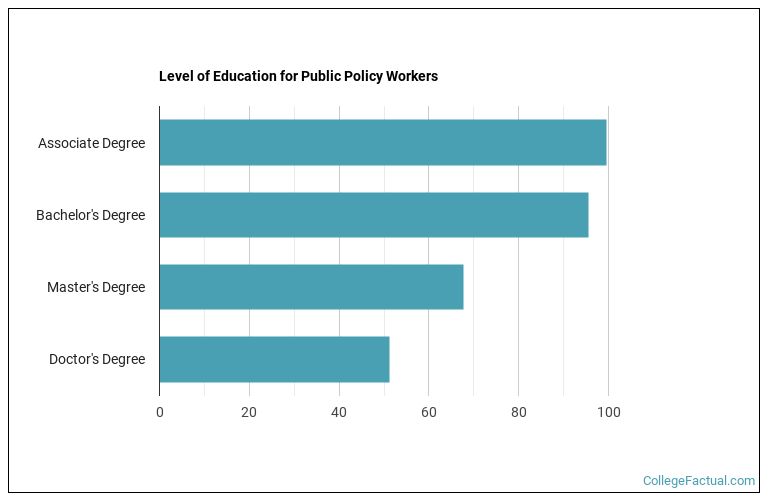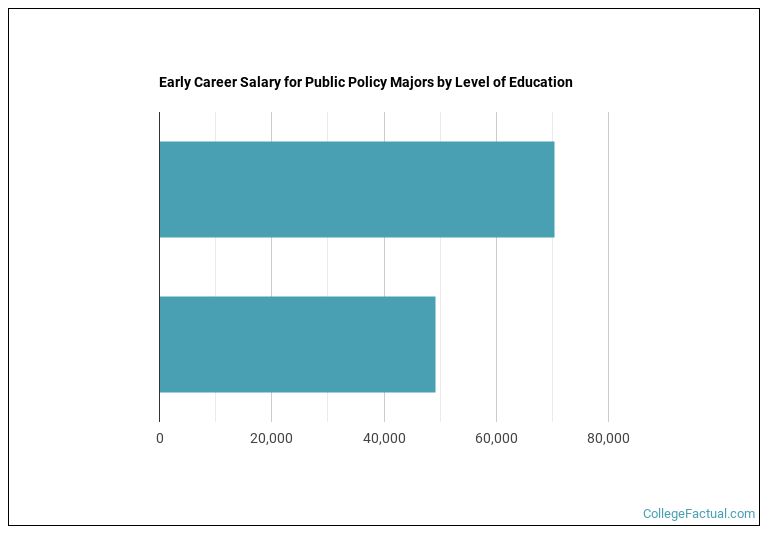 by our College Data Analytics Team
by our College Data Analytics TeamA major in Public Policy allows you go behind the political scene to learn exactly how and why public policy decisions are made. You will learn how to analyze and form public policy decisions - giving you front row access to shape today's most important economic and social issues. The curriculum focuses on theory and history as well as a wide study of current social issues.
Between a broad array of analytical techniques and practical experience, a graduate with a Public Policy degree will be prepared to influence and change policy decisions. Be ready for a heavy course load in mathematics, as this major has a strong background in economics and statistics. Concentrations include: Education Policy Analysis, Health Policy Analysis, and International Policy Analysis.
In 2021-2022, public policy was the 113th most popular major nationwide with 6,484 degrees awarded. Our 2025 Best Public Policy Schools ranking analyzes 57 of these schools to determine the best overall colleges for public policy students. Continue reading to check out one of our many unbiased rankings of public policy programs later in this article.
This is a major for those that are intellectual and curious and never take anything at face-value. A public policy analyst is interested in getting to the root of how all things work, questioning the given information, and analyzing the data. Being able to accurately interpret data is essential to this field, and strong mathematical skills are needed.
Students should also be interested in politics and have good quality people skills. You will be required to work in teams, give presentations, resolve conflicts, write for multiple audiences and engage in political networking.
public policy degree applicants generally need have finished high school or their GED. Many schools may also have GPA and SAT/ACT score minimums that must be met. In addition to these basic public policy program qualifications, to serve in some public policy careers, special certification may be required outside of your degree.
There are various different levels of public policy degrees. Public Policy programs offered by schools range from a to a , which is the highest public policy degree you can get. How long it takes to complete some common public policy degree levels is shown below.
| Degree | Credit Requirements | Typical Program Length |
|---|---|---|
| Associate Degree | 60-70 credits | 2 years |
| Bachelor’s Degree | 120 credits | 4 years |
| Master’s Degree | 50-70 credits | 1-3 years |
| Doctorate | Program required coursework including thesis or dissertation | At least 4 years |
A doctor's degree is the most common level of education achieved by those in careers related to public policy, with approximately 47.4% of workers getting one. See the the most common levels of education for public policy workers below.
| Level of Education | Percentage of Workers |
|---|---|
| Doctoral Degree | 51.1% |
| Bachelor’s Degree | 25.5% |
| Master’s Degree | 15.1% |
| Associate’s Degree (or other 2-year degree) | 3.8% |
| Post-Doctoral Training | 3.1% |
51.2% of public policy workers have at least a doctorate. View the chart below to get an idea of what degree level most of those in public policy careers have.

This of course varies depending on which public policy career you choose.
A career in public policy analysis can go in two different directions. Graduates can work producing policy analysis for formal research projects, collecting, analyzing, and summarizing their findings from primary data. A second group of jobs involves those who use analysis and research to apply the information into their policy process.
Within these two categories is an array of job titles: political scientists, economists, sociologists, lawyers, urban planners, or natural scientists, among other things. Graduates find work in many large public and private bodies, government agencies, national governance organizations, corporations, think tanks, and consultancy firms. No matter the job title, these people shape society through analyzing research.
Want a job when you graduate with your public policy degree? Public Policy careers are expected to grow 19.0% between 2016 and 2026.
The following options are some of the most in-demand careers related to public policy.
| Occupation Name | Projected Jobs | Expected Growth |
|---|---|---|
| Medical and Health Services Managers | 424,300 | 20.5% |
| Health Specialties Professors | 294,000 | 25.9% |
| Education Professors | 82,200 | 10.3% |
| Legislators | 59,400 | 7.0% |
| Social Scientists | 44,900 | 6.7% |
Public Policy graduates between <nil> reported earning an average of $62,614 in the <nil> timeframe. Earnings can range from as low as $30,303 to as high as $97,034. As you might expect, salaries for public policy graduates vary depending on the level of education that was acquired.

Salaries for public policy graduates can vary widely by the occupation you choose as well. The following table shows the top highest paying careers public policy grads often go into.
| Occupation Name | Median Average Salary |
|---|---|
| Health Specialties Professors | $122,320 |
| Political Scientists | $115,300 |
| Medical and Health Services Managers | $113,730 |
| Political Science Professors | $99,480 |
| Social Scientists | $85,750 |
With over 444 different public policy degree programs to choose from, finding the best fit for you can be a challenge. Fortunately you have come to the right place. We have analyzed all of these schools to come up with hundreds of unbiased public policy school rankings to help you with this.
One of 4 majors within the Public Administration & Social Service area of study, Public Policy has other similar majors worth exploring.
| Major | Annual Graduates |
|---|---|
| General Public Policy Analysis | 5,718 |
| Health Policy Analysis | 310 |
| International Policy Analysis | 248 |
| Other Public Policy Analysis | 123 |
| Education Policy Analysis | 85 |
| Related Major | Annual Graduates |
|---|---|
| Public Administration | 16,043 |
| Human Services | 12,541 |
| Community Organization & Advocacy | 2,872 |
| Other Public Administration | 721 |
Image Credit: By The Official CTBTO Photostream under License More about our data sources and methodologies.